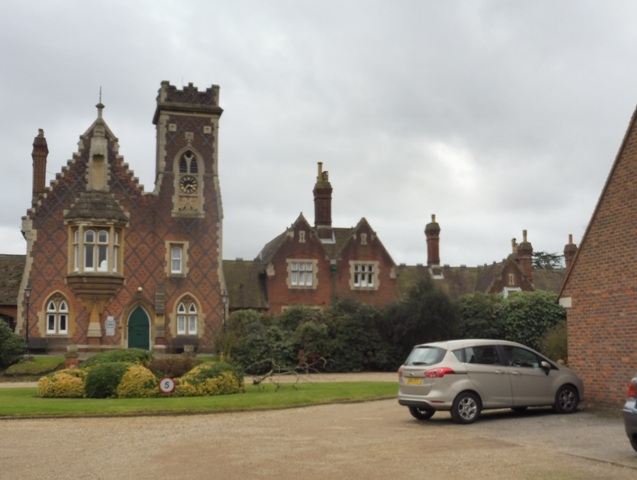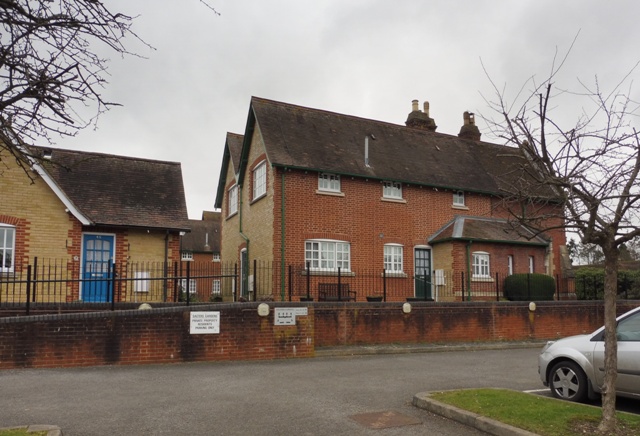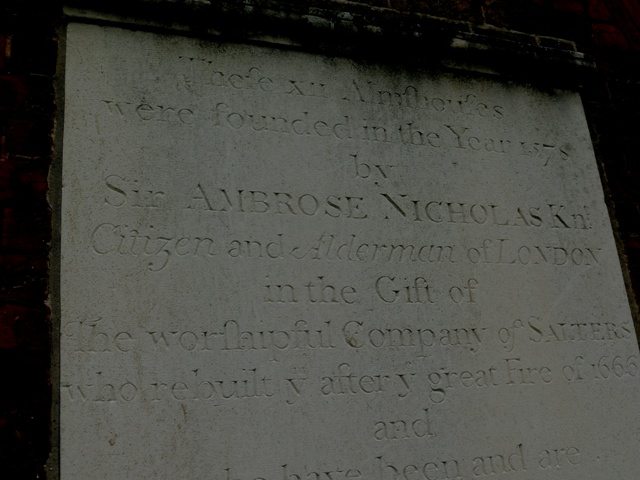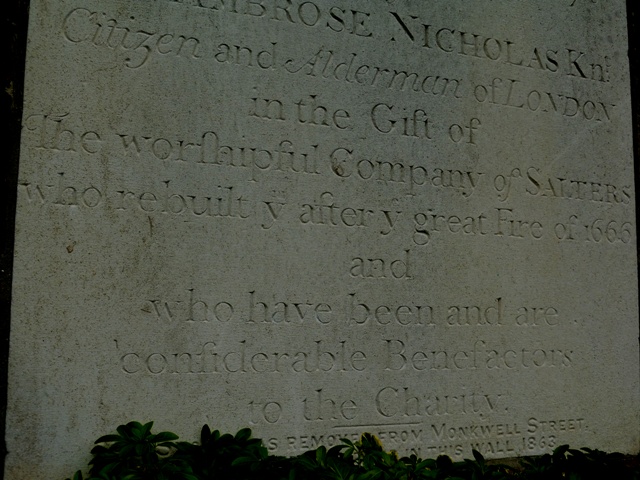Watford. Salters
Colin Wilson
A lucky look back to say goodbye to the warden suddenly answered my question. Information had been found about the Nicholas, Ambrose and Salters almshouses in Watford but the link (if any) was unclear, and another Salters almshouse on a different site was mentioned. Next to the door of the warden’s office was a stone removed from a previous establishment in London. The resolution was that Thomas Beamond founded an almshouse at Bread Street, Ambrose Nicholas founded another at Monkwell Street, these two being assigned to the Salters Company, one of the London guilds. These were relocated to Watford. The other Salter’s almshouse turned out to be a completely different establishment by David Salter, the name being a coincidence.
Foundation
Thomas Beamond (or Beaumont) was a member of the Salters Company in London. In about 1454, during the reign of Henry VI, he gave Salters Hall in Bread Street (between the Mansion House and St Paul’s Cathedral) and established an almshouse for 6 men next door.
In 1578 Sir Ambrose Nicholas founded an almshouse in Monkwell Street, Cripplegate, for 7 men and 5 women, freemen of the Salters Company. It seems they were to the north of St Paul’s Cathedral and London Wall at what is now known as Monkwell Square. They are mentioned in his will so were probably built just before his death.
The almspeople were given a black gown following his death, and 5 sacks of coal each Christmas. This latter from Nicholas’ will had an interesting aspect. Two apprentices were lent a sum of money interest free, but one of the requirements was that they should provide the coals for the almspeople. Maybe this would instil in them some of the philanthropic ideas shown by Nicholas and the Guild.
Rebuilding
Salters Hall and both almshouses were destroyed in the Great Fire of London in 1666. As Monkwell Street is just on the northern limits of the fire, you could say there was an element of being unlucky. They were rebuilt by the Salters Company. A sketch from 1852 showing the imposing buildings is held at London Metropolitan Archives. My assumption is that the two institutions were combined in the new building, although the datestone only mentions Nicholas and an 1867 reference has been found to Bow Lane.
Relocation
By 1863 the area was needed for new warehousing, and a suitable site for a new building was found on the north west outskirts of Watford (the area has since been absorbed into Watford). The dedication stone was moved there from Monkwell Street to preserve some continuity.
English Heritage cites T C Sorby as the architect, while Illustrated London News Jul 30 1864 records the architect as John Collier of Putney, and the builder Mr King of Shefford in Bedfordshire. The latter issue includes an etching produced from a photograph. Either way, the cost was £8000 plus the cost of the land. It was built in the Gothic style, to house 12 females and 8 males. The opening ceremonies were reported in the local newspapers.
New chimneys were needed as early as 1878. Water supply and drainage became issues in the later 19th century. Land in the area was advertised for development from about 1867, and it seems that new sewers were installed, but issues arose at times for the next 40 years. While the details are sketchy, it looks as if some areas had adequate sewerage while others did not. This did entail some expense for the Salters Company towards the end of the 19th century.
Lease
In 1992 the Salters Company granted a long lease to Warden Housing Association (now known as Home Group) who redeveloped the site for 39 residents. The present accommodation consists of the Gothic style building along with modern brick-built bungalows. The Company retained the rights to 12 units within the development. This entitles The Salters’ Company to make recommendation of elderly residents in need, over the age of 60 and with limited means who meet the criteria of The Salters’ Company Almshouse Trust. Residents should be capable of independent living and have friends or family within the local area. The premises are Warden Assisted five days a week, with emergency facilities out of hours. The rent is set by the Housing Association and includes a monthly maintenance and supporting people charge.
The building was been listed by English Heritage (ref 1348084) in January 1983. The accommodation now comprises the original Gothic building along with a number of more modern brick-built bungalows.
The almshouses are affiliated to the Almshouse Association and registered with the Charities Commission ref 226799.
Other Information
Fire comes into the story a number of times. The Salters Hall given by Beamond was burnt down in 1533, 1539 and 1598. Ambrose Nicholas was buried in St Mildred’s, Bread Street, which succumbed to the Great Fire of 1666, along with the almshouse in Monkwell Street.
Theft took place even while the Watford almshouses were being built. George Evans, a labourer, was sentenced to six months’ imprisonment with hard labour for stealing 113 lbs. of lead, the property of his master, Mr. John King, of Watford, which was to be used for the almshouses.
Some land was sold off in 1880.
Hertfordshire Archives holds a bundle of documents (ref DP/117A/7/1) concerning the right to reserve pews for inhabitants of the Salters’ Company’s almshouses in return for annual payments.
The usual death notices are reported in the newspapers, mostly showing ages between about 70 and 88. Two are of some interest. In 1892 Eliza Martin was killed after she fainted while boarding a train at South Acton, indicating at least some of the residents travelled around. Unfortunately this resulted in a broken arm and transfer to Watford hospital, where she died as a result of heart complications. Jane Sophia Emmerson died at the almshouse aged just 27. Was she living with a relative?
An 1864 trial report notes that a Mr Marten was assaulted. This would be soon after the almshouse was opened. His wife gave evidence, indicating that married couples were allowed.
Dr F H Wilson Iles was surgeon to the Salter’s Almshouses among many other activities, hence there was some medical provision for the residents.
A Bible class was held at the almshouses in the 1890s.
Location
Church Road, Watford WD17 4QE
Georef: 510454 197741
Grid Ref: 51o 40′ 04″N 0o 24′ 16″W
OS 25″ map Hertfordshire XXXIX.14 pub 1896 shows the location. Subsequent versions show how the area developed.
References
Any websites accessed Sept 2020
The Book of Watford: a Portrait of Our Town c1800 -1987 compiled Bob Nunn
Page 46
pub Pageprint 1987
HALS Document reference: DP/117A/7/1 is a bundle of documents about the right to reserve pews for inhabitants of the Salters’ Company’s almshouses in return for annual payments
London Metropolitan Archives Collage website has drawings of Monkwell Street almshouses at https://collage.cityoflondon.gov.uk/quick-search?q=salters%20almshouse&WINID=1529345963260
Historic England’s listing can be found at https://www.historicengland.org.uk/listing/the-list/list-entry/1348084
Charity Commission http://beta.charitycommission.gov.uk/charity-details/?regid=226799&subid=0
Salters Company website has useful information at
https://www.salters.co.uk/the-salters-company/company-history/ and https://www.salters.co.uk/the-charities/almshouses/
http://www.victorianlondon.org/houses/almshouses.htm
http://www.british-history.ac.uk/no-series/dictionary-of-london/salters-almshouses-sandys-place records the Monkwell Street almshouses.
https://en.wikipedia.org/wiki/Ambrose_Nicholas includes biographical details.
https://www.geni.com/people/Sir-Ambrose-Nicholas-Lord-Mayor-of-London/6000000020323051181 includes details of Ambrose Nicholas’ life.
http://www.oxford-shakespeare.com/Probate/PROB_11-60_ff_165-7.pdf includes Ambrose Nicholas’ will.
https://www.british-history.ac.uk/livery-companies-commission/vol4/pp502-510
City of London Livery Companies Commission. Report; Volume 4. Originally published by Eyre and Spottiswoode, London, 1884. This detailed article is about income and payments at the time the almshouses were to be moved to Watford
The records of St Mildred’s church Bread Street note that Nicholas had a monument in the church..https://archive.org/stream/registersofstmil42stmi/registersofstmil42stmi_djvu.txt
Illustrated London News Jul 30 1864 records the opening, and includes an illustration.
Newspapers can be accessed online at British Newspaper Archives
Building and Opening
Herts Guardian, Agricultural Journal, and General Advertiser Tuesday 24 May 1864 p2 c2
Herts Guardian, Agricultural Journal, and General Advertiser Saturday 28 May 1864 p5
Watford Observer Saturday 28 May 1864 p 1 c4
Hertford Mercury and Reformer Saturday 28 May 1864 p 3
New chimneys for Salters’ Almshouses. Watford Observer Saturday 09 November 1878 p4 c4
Watford Observer Saturday 21 April 1894 p4 c4. 500th anniversary celebration.
Land Sale 1880
Watford Observer Saturday 19 June 1880 p1 c2
Watford Observer Saturday 03 July 1880 p4
Drainage 1877
Herts Advertiser Saturday 09 June 1877 p7 c2
Herts Advertiser Saturday 14 July 1877 p7
Watford Observer 11 October 1877 p4 c2
Watford Observer Saturday 15 December 1877 p3 c1
Drainage 1907
Watford Observer Saturday 30 November 1907 p3 c3
Water Supply
Watford Observer Saturday 25 July 1885 p3 c1
Watford Observer Saturday 05 March 1887 p4
Herts Advertiser Saturday 02 September 1893 p8 c1
Anecdotes
Watford Observer 13 April 1867 p1 c4. Advert for house.
Hertford Mercury and Reformer 31 October 1863 p3 c2. Lead theft.
Hertford Mercury and Reformer Saturday 29 September 1883 p3. Francis Henry Wilson Iles.
Watford Observer Saturday 13 December 1890 p4 c2. Bible class.
Watford Observer Saturday 17 December 1864 p1 c7. Mr & Mrs Marten.
Death Notices
Watford Observer 11 March 1865 p1 c7. Mr. Samuel Martin, aged 76.
Watford Observer 09 December 1865 p4. Mrs. Harriet Wicks, aged 69.
Herts Advertiser 04 May 1867 p3. Miss La brow, aged 70.
Herts Advertiser 18 February 1871 p8. Martha, widow of Mr. Joseph Chester, aged 84.
Watford Observer 22 April 1871 p4 c7. Martha Sophia, widow of Mr. William Evitt, aged 82 years.
Herts Advertiser 22 April 1871 p8. Martha Sophia, widow of Mr. Wm. Evitt, aged 82.
Herts Advertiser 24 August 1878 p8. Jane, widow of Wm. Montague, aged 67 years. August 14.
Herts Saturday 17 February 1883 p8. Hannah Grant, widow of the late George Miller, aged 82.
Herts Advertiser 08 October 1887 p8. Charlotte Poxwell, aged 88
Herts Advertiser 24 March 1888 p9 c7. Cooke. March 18, , aged 73 years.
Herts Advertiser 09 March 1889 p8. Eliza Martin, aged 57.
Herts Advertiser 10 August 1889 p8. Mary Ann Hunt August 7, aged 83.
Herts Advertiser 17 August 1889 p8. Mary Ann Hunt, August 7, aged 83.
JHerts Advertiser 22 August 1891 p8 c7. ane Sophia Emmerson, August 13. aged 27.
Herts Advertiser 02 July 1892 p7 c1. Eliza Martin, 72,












Add your comment about this page
No specific comment – but I would like to ask if there is any stained glass in the old buildings? I ask this as I believe that Thomas Willement FSA (1786-1871) designed and executed some stained glass in the premises.
If so, would it be possible for me to come and photograph what there is?
With thanks
Priscilla Frost
If you contact the Salters Company (Worshipful Company of Salters) they should be able to provide further information